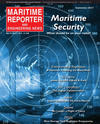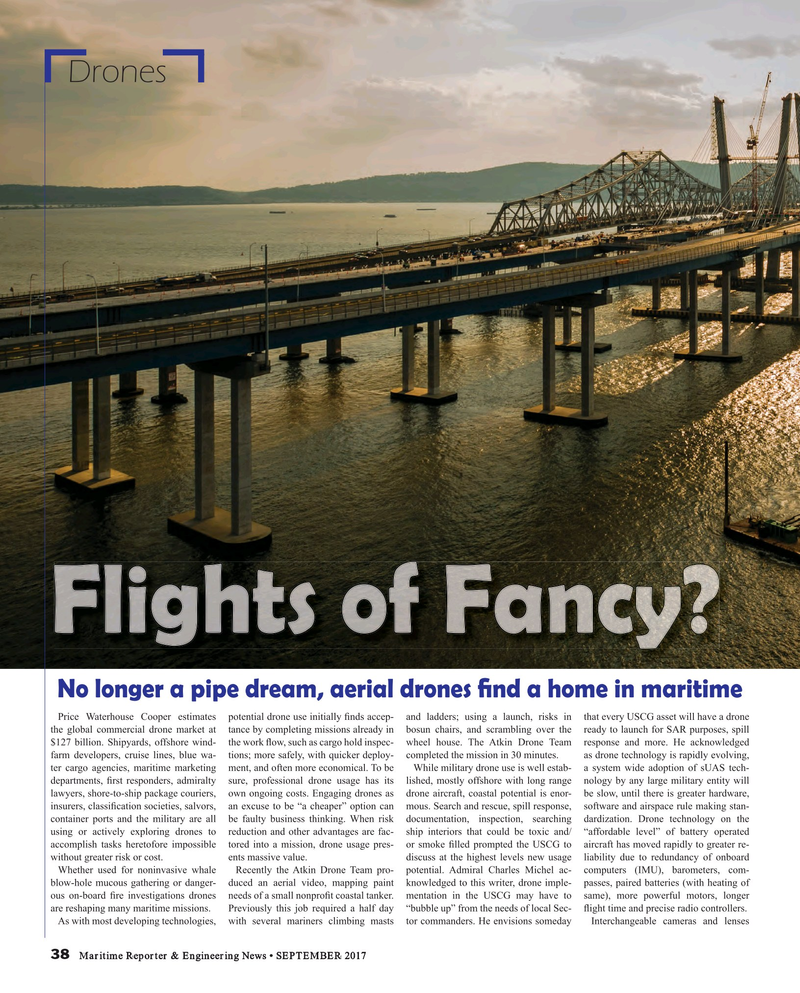
Page 38: of Maritime Reporter Magazine (September 2017)
U.S. Navy Quarterly
Read this page in Pdf, Flash or Html5 edition of September 2017 Maritime Reporter Magazine
Drones
No longer a pipe dream, aerial drones ? nd a home in maritime
Price Waterhouse Cooper estimates potential drone use initially ? nds accep- and ladders; using a launch, risks in that every USCG asset will have a drone the global commercial drone market at tance by completing missions already in bosun chairs, and scrambling over the ready to launch for SAR purposes, spill $127 billion. Shipyards, offshore wind- the work ? ow, such as cargo hold inspec- wheel house. The Atkin Drone Team response and more. He acknowledged farm developers, cruise lines, blue wa- tions; more safely, with quicker deploy- completed the mission in 30 minutes. as drone technology is rapidly evolving, ter cargo agencies, maritime marketing ment, and often more economical. To be While military drone use is well estab- a system wide adoption of sUAS tech- departments, ? rst responders, admiralty sure, professional drone usage has its lished, mostly offshore with long range nology by any large military entity will lawyers, shore-to-ship package couriers, own ongoing costs. Engaging drones as drone aircraft, coastal potential is enor- be slow, until there is greater hardware, insurers, classi? cation societies, salvors, an excuse to be “a cheaper” option can mous. Search and rescue, spill response, software and airspace rule making stan- container ports and the military are all be faulty business thinking. When risk documentation, inspection, searching dardization. Drone technology on the using or actively exploring drones to reduction and other advantages are fac- ship interiors that could be toxic and/ “affordable level” of battery operated accomplish tasks heretofore impossible tored into a mission, drone usage pres- or smoke ? lled prompted the USCG to aircraft has moved rapidly to greater re- without greater risk or cost. ents massive value. discuss at the highest levels new usage liability due to redundancy of onboard
Whether used for noninvasive whale Recently the Atkin Drone Team pro- potential. Admiral Charles Michel ac- computers (IMU), barometers, com- blow-hole mucous gathering or danger- duced an aerial video, mapping paint knowledged to this writer, drone imple- passes, paired batteries (with heating of ous on-board ? re investigations drones needs of a small nonpro? t coastal tanker. mentation in the USCG may have to same), more powerful motors, longer are reshaping many maritime missions. Previously this job required a half day “bubble up” from the needs of local Sec- ? ight time and precise radio controllers.
As with most developing technologies, with several mariners climbing masts tor commanders. He envisions someday Interchangeable cameras and lenses 38 Maritime Reporter & Engineering News • SEPTEMBER 2017
MR #9 (34-41).indd 38 MR #9 (34-41).indd 38 9/6/2017 11:08:27 AM9/6/2017 11:08:27 AM

 37
37

 39
39
